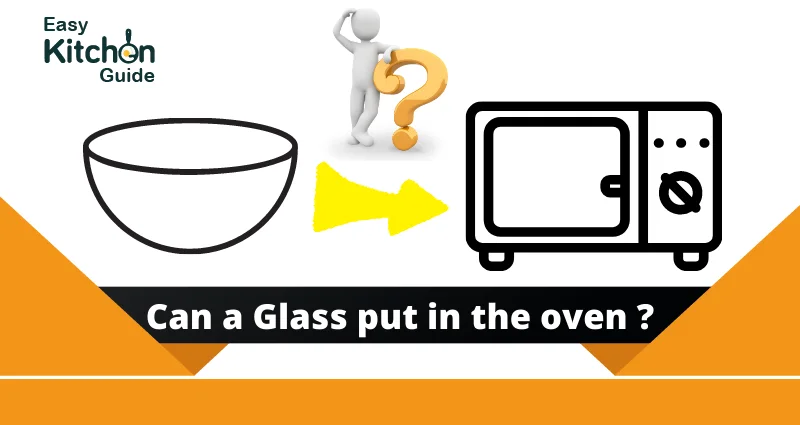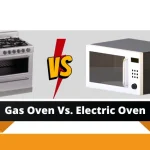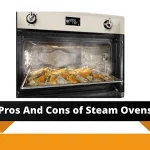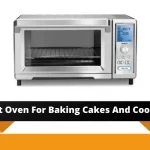Yes, you can put glass in the oven as they are mostly oven safe. The glass, particularlyPyrex, Borosilicate, Anchor Hocking, and Corningwarecan withstand high temperatures of the oven. but there are only certain types of glass which are oven safe and we cannot put any kind of glass in the oven.
The question of putting glass in the oven always comes to your mind when you want to reheat the leftovers stored in glass jars. There’s always the fear of glass shattering in the oven, so how to know if the glass is oven-safe?
Based on my personal experience and research, I will go through every detail that will be helpful for readers to know more about oven-safe glass. However, the causes of glass breakage in the oven and the benefits of using glass will also be discussed later in this article.
Can you put glass in the Oven?
Table of Contents,
You can put the glass in the oven at one condition if it is oven safe or can tolerate the temperature up to 400 F max. Otherwise, it may break in the oven. The glass that is damaged or thin should not be used in the oven.
The glass breaks when it experiences a temperature shock. It also depends upon the type of glass you’re using in the oven and its temperature limit. Therefore, glass can be used to reheat or reheat your food if precautions are taken.
There are many oven-safe dishes and containers that you can find at your nearby store. if you ask me then I am personally using Round Bovado USA Glass Bowl which is not only microwave safe but also dishwasher safe. Moreover, you can get these bowls in different sizes from 1 Quart to 4 Quarts.
How to know if the glass is oven-safe?
This is a mandatory question that you should consider before putting a glass in the oven. If you don’t know about the maximum temperature limit of your glass then you should not take the risk.
Before buying a glass, always check the underside of the glass where it has “temperature range” and “oven-safe” marks. Don’t buy a glass that is not oven safe or has a low-temperature range because it will easily break in the oven. Moreover, tempered glass is oven-safe than non-tempered glass.
Pyrex glass can withstand a temperature limit between 350-420 F. Anchor Hocking, Libbey Baker and Corningware are best for baking purposes. So, don’t worry, a glass pyrex can go in the oven without any risk. Let’s have a look at different types of glass that can be used in an oven.
Can a Pyrex Glass go in the oven?
Yes, Pyrex glass is an oven-safe product that is widely used for baking, heating, freezing, and reheating food. The recommended temperature for pyrex glass is up to 450F. Pyrex glass has low thermal expansion and is an excellent container. It is also used in laboratories due to its exceptional properties.
Pyrex glass can withstand temperature ranges from 350-420 F and can be safely used in an oven. However, sudden thermal expansion and temperature shock result in the breakage of the glass. That’s why every glass should be used by following precautionary measures.
Make sure that you never use Pyrex glass directly on the stovetop, as it will cause damage to the glass or shatter the dish.
- Pyrex Glass can also be tempered through the chemical or thermal method
- Pyrex glass can withstand maximum temperature i.e 450 degrees to 914degrees
- Pyrex glass is the oldest invention and was introduced in the markets in 1900
- The thickness of Pyrex glass lies between 0.20 to 21/4 inches
there are several payrex glass options are in the market, I recommend you to give a try to Pyrex Circular Glass Storage which is available in different sizes and storage capacities.

Can tempered glass go in the oven?
Yes, tempered glass is another type of glass that is oven safe and can be used safely in the oven. Tempered glass is a durable and tough form of glass that has high thermal shock resistance. Tempered glass can also withstand high temperatures and have low thermal expansion. Tempered glass has a lower risk of breaking than other types of glass. It is 65 to 75 percent more durable than others.
The most common type of tempered glass is tempered soda glass that is used for baking and cooking. The temperature range of tempered glass is up to 470F because it is strengthened by chemical and thermal treatment. Moreover, the drinking glass made up of tempered glass is also oven safe and five times more durable than regular glass.
Is the Borosilicate Glass oven safe?
Yes, borosilicate glass is oven-safe glass that can tolerate high-temperature ranges i.e. up to 350 F to 450F. So, we can say that borosilicate glass will not break or shatter when placed in an oven at a high temperature. Borosilicate glass can safely be put in the oven because it has low thermal expansion and higher thermal shock resistance. And these properties should be present in the glass.
Moreover, borosilicate glass was introduced in markets earlier than pyrex glass production. And, it is more durable and reliable. Borosilicate glass can also withstand extreme temperature changes.
The only difference between soda-lime and borosilicate glass is that the former one can withstand higher temperature changes which makes it an ideal glass. It can be used for baking, cooking, and heating purposes. It is also used in laboratories and is more durable, harder, and stronger than regular or pyrex glass.
You can find many varieties in borosilicate glass, however, the best quality baking dish is CRYSTALIA Glass Baking Dish for Oven, which is made up of borosilicate glass.
Now let’s Study Different types of glass and their resistance against high temperature.
PyroCeram Glass – (Heat resistant glass)
PyroCream glass is another type of glass that is oven safe and can tolerate high temperatures in the oven. It is also heat-resistant glass and can withstand temperature ranges between 1300 degrees to 1427 degrees.
Pyroceram glass can also be used cooking tops in the oven or at the fireplace. It is also effective in blocking Uv rays and has high thermal shock resistance. PyroCeram glass cookware is best to use at a fireplace. It is available in 0.20-inch thickness and only in clear or white colors.
Pouring cold water on the hot surface of Pyro Serum glass does not break or shatter the glass. This property makes pyroceram an ideal heat-resistant glass.
Robax Glass
Robax is an excellent heat-resistant glass that can tolerate temperatures up to 1400 degrees. Robax can also withstand both fire and ice because it can also operate at lower temperature ranges such as 400F. Robax also has high thermal shock resistance and tolerates sudden shifts in temperature.
- The thickness of the glass varies between 118 inches to .197 inches.
- Robax has low thermal expansion and high resistance
- It is available in various colors with myriad texture
- Robax is durable, tough, and hard
- It is also available in round, a flat and angular shape
Also, Read Trending Topics
- Steam clean oven vs Self-clean? Which One Is better?
- Why do Pans and Baking Sheets Warp in the Oven? (How to Stop)
- 6 Best Countertop Steam Ovens in 2023 for Your Kitchen
What causes the glass to break in the oven?
Below are the potential factors that cause the glass to shatter in the oven. We recommend avoiding such reasons which result in damage.
Sudden temperature shift
One of the prime reasons for glass breaking in the oven is temperature shock. When a glass can’t tolerate a sudden shift of temperature from cold to hot or from hot to cold temperature it breaks easily.
It is recommended to leave a glass container at room temperature for 25-30 minutes before putting it in the oven. Avoid putting the container immediately in the oven after removing it from the freezer.
Temperature shock occurs when a glass suddenly moves from freezer to oven or from oven to freezer. It also happens when cold water is poured on a hot surface of the glass. This causes the glass to expand or contract or break.
High temperature
When glass is heated above the recommended temperature range it breaks in the oven. High temperature is the most common reason for glass breakage in the oven.
Always heat your glass container below the recommended temperature. It will also lower the risk of glass breakage. A safe temperature limit for an oven-safe glass is 320-450F.
Using damaged or incorrect types of glass
The cracked and damaged glass should not be used in the oven as it will break easily in the oven. Damaged glass has low structural strength which causes breakage.
The Glass that is marked with the oven-safe symbol can be safely used in the oven. However, the wrong type of glass should not be used in ovens that have not been treated, are tempered, and have not been labeled as oven safe.
How to avoid glass from breaking in the oven?
If you follow some precautions that are listed below you can avoid glass from breaking in the oven. So, check out our great tips on this topic.
Check for an oven-safe label
Only buy that glass container and baking dishes that are marked with an oven-safe label, otherwise don’t take risks at all. Avoid putting regular glass in the oven because it can’t tolerate high temperatures and breaks quickly.
Don’t give temperature shock to your glass
Avoid drastic changes in temperature, as this will break the glass in the oven. Even the oven-safe glass and dishes can’t withstand a sudden change in the temperature. So, it’s better to leave the glass container at room temperature for a maximum of 30 minutes before putting it in the oven.
Use the correct type of glass
If you’re confused about the type of glass, go for pyrex, tempered, and borosilicate glass. These types of glass are oven-safe and have a high thermal shock. Borosilicate glass can tolerate temperatures up to 470F.
Add liquid to the bottom
Adding water to the bottom of the dish while baking avoids the thermal shock. Because a small amount of water usually comes out during baking, so if we have already put water in the pot, it will prevent the glass from breaking.
Avoid high temperatures
High temperatures are the prime cause of glass breakage in the oven. You should only heat glass at the recommended temperature. However, a safe temperature for glass ranges between 320-450F.
Benefits of heating food in the glass container
What benefits do you get by using glass containers? Why do we prefer to use glass containers for heating food?. There are tremendous benefits of using glass containers for heating food, some of them are listed below.
- Glass containers are nonstick, and like other materials, they don’t release toxins
- They can retain heat for a longer time
- Glass containers have multi-purpose uses such as baking, cooking, freezing, or storing
- Easy to clean
- Glass containers absorb heat
- You can watch your food while cooking and baking
Frequently Asked Questions
Glass jars are not oven-safe, so they are not designed for baking, cooking, or heating purposes. You should only use cookware or glass that is oven safe or can tolerate high temperatures in the oven.
You should only put glass that is oven-safe such as pyrex, tempered, or borosilicate glass. So, glass can be put in the oven if it is oven safe.
Don’t use non-tempered or regular glass in the oven because they will break easily.
Before putting a glass in the oven, look for the oven-safe symbol at its bottom. Don’t use a glass that is not oven safe. Pyrex tempered and borosilicate glass is always safe for oven use.
Conculsion
Based on research and personal experience, I can say that we can safely use the glass in the oven if we follow the precautions and recommendations mentioned above. So, always use oven-safe and tempered glass to avoid any damage.







